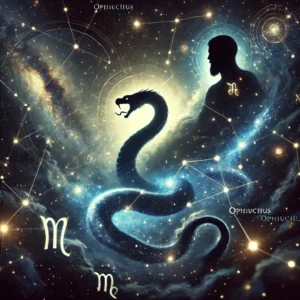
Ophiuchus, the mysterious 13th zodiac sign, has always been surrounded by intrigue. As the “Serpent-Bearer,” it represents transformation, knowledge, and power, yet it is notably absent from the traditional zodiac system. Why was Ophiuchus removed from the zodiac, and what does its exclusion reveal about astrology’s evolution?
Discover why Ophiuchus, the mysterious 13th zodiac sign, was excluded from the traditional zodiac and its impact on astrology.
What Is The Original Zodiac System?
The zodiac as we know it today is based on twelve signs, each corresponding to a specific constellation along the ecliptic—the sun’s apparent path through the sky.
Ancient Babylonian astrologers established this twelve-sign system over 2,500 years ago for simplicity and symmetry.
By dividing the year into twelve equal parts, each assigned to a zodiac sign, they created a structure that aligned neatly with their calendar.
However, there were actually 13 constellations along the ecliptic, with Ophiuchus being the one left out. Its placement in the zodiac belt between Scorpio and Sagittarius meant it fit astrologically, but for practical reasons, it was excluded.
Why Was Ophiuchus Removed ?
1. The Challenge of Symmetry
The twelve-sign zodiac aligns perfectly with the 12 months of the year, creating a balanced and orderly system. Including Ophiuchus would have disrupted this balance, requiring astrologers to either divide the calendar differently or redefine each zodiac’s time frame. To maintain simplicity, Ophiuchus was removed.
2. Cultural and Mythological Fit
Each zodiac sign has long-standing associations with mythology, symbolism, and personality traits. Ophiuchus, as the “Serpent-Bearer,” introduced themes of duality and transformation that did not align with the established system. Its presence challenged traditional astrological archetypes, making it an outlier.
3. Astronomical Adjustments
Astronomy, unlike astrology, recognizes Ophiuchus as one of the constellations along the ecliptic. However, due to changes in the Earth’s axis (a phenomenon known as precession), the positions of constellations relative to the zodiac have shifted over millennia. Ophiuchus, sitting in a transitional space, was easier to exclude than to integrate into the shifting zodiac framework.
Should Ophiuchus Be Included?
The exclusion of Ophiuchus from the zodiac continues to spark debate among astrologers. While some argue that its inclusion would enhance astrology by embracing its full complexity, others believe its themes disrupt the zodiac’s traditional harmony. In recent years, the sign has gained more recognition, particularly among those exploring the Dark Zodiac or alternative systems of astrology.
Including Ophiuchus would shift the zodiac calendar significantly, altering birth sign dates for millions of people. For example, someone previously considered a Sagittarius might now fall under Ophiuchus. This disruption to the established order is one of the reasons why its inclusion remains controversial.
What Is The Legacy of Ophiuchus?
Although excluded from the traditional zodiac, Ophiuchus holds a unique place in astrology and mythology. It challenges us to think beyond the twelve signs, encouraging exploration of themes like transformation, shadow work, and the balance of light and dark. Its very exclusion underscores its disruptive power—a force that refuses to conform to established systems.
Why Was Ophiuchus Removed? – Conclusion
The removal of Ophiuchus from the zodiac was a decision rooted in practicality, but its legacy persists. As a sign of disruption and renewal, Ophiuchus continues to inspire curiosity and debate. Whether embraced as the 13th sign or viewed as a mythological outlier, its influence cannot be ignored.
Are you ready to explore the transformative power of the serpent-bearer? Dive deeper into the mysteries of Ophiuchus and its place in astrology.
FAQ: The Shunned Serpent—Why Ophiuchus Was Erased
What is Ophiuchus, and why is it a forbidden sign?
Ophiuchus, the Serpent-Bearer, is the 13th zodiac sign, a celestial outcast nestled between Scorpio and Sagittarius. It embodies healing, rebellion, and forbidden wisdom, its serpentine power too chaotic for traditional astrology’s ordered wheel. Shunned for disrupting cosmic balance, it unveils the shadow truths of the soul, a dangerous force that defies the zodiac’s conventional harmony.
Why was Ophiuchus removed from the zodiac?
Ophiuchus was cast out by ancient Babylonian astrologers to maintain a neat 12-sign zodiac, aligned with their calendar’s 12 months. Its disruptive energy and shifting constellation boundaries threatened the system’s symmetry. Modern astrology upholds this exclusion, fearing Ophiuchus’s chaotic duality—its blend of healing and destruction—would unravel the predictable order of the celestial narrative.
What are the origins and symbolism of Ophiuchus?
Ophiuchus stems from ancient myths, tied to Asclepius, the Greek healer wielding serpents of rebirth and forbidden knowledge. Known in Babylonian star charts, it symbolizes duality—life and death, wisdom and chaos. In the Dark Zodiac, Ophiuchus is the Serpent-Bearer, a renegade force embodying raw power and the untamed psyche, exiled yet potent in its cosmic influence.
How does Ophiuchus connect to shadow work?
Ophiuchus fuels shadow work by exposing the suppressed chaos within—rebellion, desire, or destructive impulses. As the Serpent-Bearer, it maps these hidden facets in your birth chart, guiding you to confront and harness them. Through dark rituals and introspection, Ophiuchus transforms your inner turmoil into wisdom, embracing the healer and destroyer lurking in your soul.
Who should seek Ophiuchus’s exiled truths?
Ophiuchus calls to those drawn to the forbidden—born between November 29 and December 17 or captivated by cosmic rebellion. It’s for the fearless, the occult enthusiasts, and those craving raw truth over order. Seekers ready to face their shadow selves through gothic rituals and the Dark Zodiac’s mysteries will find Ophiuchus a haunting guide to their soul’s depths.
